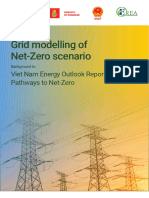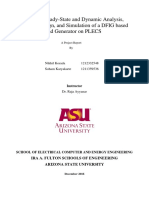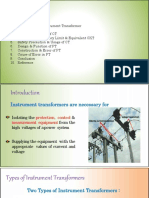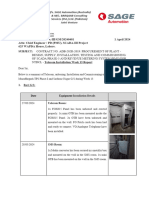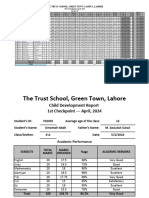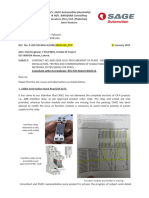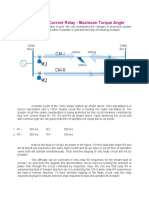Zorlu Solar - Report
Zorlu Solar - Report
Uploaded by
tayyab zafarCopyright:
Available Formats
Zorlu Solar - Report
Zorlu Solar - Report
Uploaded by
tayyab zafarCopyright
Available Formats
Share this document
Did you find this document useful?
Is this content inappropriate?
Copyright:
Available Formats
Zorlu Solar - Report
Zorlu Solar - Report
Uploaded by
tayyab zafarCopyright:
Available Formats
Report No. PPI-256.
3-Final/18
INTERCONNECTION STUDY
For
100 MWp Solar Power Project by
Zorlu Solar Pakistan Limited
Final Report
(January 2018)
POWER PLANNERS INTERNATIONAL LTD.
Registered in England & Wales No. 6363482
UK Office: Pakistan Office:
3-Sylvester Road, 95-H/2, Wapda Town,
Sudbury Town, Middlesex, Lahore 54770, Pakistan
HA0 3AQ, UK Phone: +92-42-35182835;
Phone & Fax:+44-(0)208-9223219 Fax: + 92-42-35183166
Email: info@powerplannersint.com
www.powerplannersint.com
Executive Summary
The data received from the client is validated and the study objective, approach
and methodology have been described. The net AC output power of the plant to
the grid would be 78 MW.
The system data provided to PPI as per NTDC Letter No. GMPP/CEMP/TRP-
380/827-29 dated 14-02-2017 has been used. The Solar Power Plant data as
provided by the client has been used. This has been attached in Appendix-A
The expected COD of Solar PP by Zorlu Solar Pakistan Limited (referred to as
Zorlu Solar-I in the remainder of the report) is in the fourth quarter of 2018. The
nearest substation is the recently constructed Lal-Sohanra 220/132 kV Substation.
Given the location of Zorlu Solar-I power plant, the most feasible interconnection
scheme would be a direct 132 kV double circuit from Zorlu Solar-I PP to Lal
Sohanra 220/132 kV substation. The distance of the site of solar plant from the
grid station ,as verified from site visit is approximately 2 km. The conductor used
would be Rail with a thermal capacity of 202 MVA. The final scheme of circuits
is shown in Appendix – A.
The above proposed interconnection scheme has been tested for steady state, short
circuit and transient stability conditions through detailed technical studies.
Detailed load flow studies have been carried out for the peak conditions of
Summer 2019. Similarly, a future scenario of Summer 2021 is also studied for the
proposed scheme under normal and N-1 contingency conditions to meet the
reliability criteria.
Steady state analysis by load flow for all the scenarios described above reveals
that the proposed scheme is adequate to evacuate the maximum net AC power of
78 MW of the plant under normal and contingency conditions.
The short circuit analysis has been carried out to calculate maximum fault levels
at the Zorlu Solar-I Power Plant 132 kV, and the substations of 132 kV in its
vicinity. We find that the fault currents for the proposed scheme are much less
than the rated short circuit capacities of switchgear installed at these substations.
There are no violations of exceeding the rating of the equipment due to
contribution of fault current from Zorlu Solar-I Power Plant.
POWER PLANNERS INTERNATIONAL PAGE 2 OF 31
The maximum short circuit level of 132 kV bus bar of Zorlu Solar-I Power Plant
is 8.88 kA and 7.71 kA for 3-phase and 1-phase faults respectively for the year
2021. Therefore industry standard switchgear of the short circuit rating of 40 kA
would be fine to be installed at 132 kV switchyard of Zorlu-Solar-PP as per
NTDC requirement taking care of any future generation additions and system
The dynamic stability analysis of proposed scheme of interconnection has been
carried out. The stability check for the worst case of three phase fault right on the
132 kV bus bar of the Zorlu Solar-I power plant substation followed by the final
trip of 132 kV circuits emanating from this substation, has been performed for
fault clearing of 5 cycles (100 ms). The system is found strong enough to stay
stable and recovered with fast damping. The proposed scheme successfully passed
the dynamic stability checks for near and far faults.
The proposed scheme of interconnection has no technical constraints or problems,
it fulfills all the criteria of reliability and stability under steady state load flow,
contingency load flows, short circuit currents, dynamic/transient conditions and
power quality; and is therefore recommended to be adopted.
POWER PLANNERS INTERNATIONAL PAGE 3 OF 31
Report Contents
1. Introduction
1.1. Background
1.2. Objectives
1.3. Planning Criteria
2. Assumptions of Data
2.1 Solar Power Plant Data
2.2 Network Data
3. Study Approach & Methodology
3.1 Understanding of the Problem
3.2 Approach to the Problem
4. Development of Scheme of Interconnection
4.1 The Proposed Network for Zorlu Solar-I Power Plant
4.2 The Scheme of Interconnection of Zorlu Solar-I Power Plant
4.3 Solar Plant Substation 132/33 kV
5 Detailed Load Flow Studies
5.1 Modeling of Solar Power Plant in the Load Flow
5.2 Reactive Power Requirements
5.3 Base Case Peak Summer 2019, Without Solar Power Plant
5.4 Load Flow with Zorlu Solar Power Plant-Case Summer 2019
5.5 Load Flow with Zorlu Solar Power Plant-Peak Load Case Summer 2021
5.6 Conclusion of Load Flow Analysis
6. Short Circuit Analysis
6.1 Methodology and Assumptions
6.2 Fault current calculations without Zorlu Solar-I Power Plant
6.3 Fault current calculations with Zorlu Solar-I Power Plant Interconnected
6.4 Conclusion of short circuit analysis
7. Transient Stability Analysis
7.1 Assumptions & Methodology
7.1.1 Stability Models
7.1.2 System Conditions
POWER PLANNERS INTERNATIONAL PAGE 4 OF 31
7.1.3 Presentation of Results
7.1.4 Worst Fault Cases
7.2 Transient stability Simulation Results
7.2.1 Fault at 132 kV Zorlu Solar-I
7.2.2 Fault at 132 kV Zorlu Solar-I (Stuck Breaker Case)
7.2.3 Fault at 33 kV Zorlu Solar-I (Trip Single Transformer)
7.3 Conclusion of Dynamic Stability Analysis
8. Conclusions
Appendices
Appendix –A: 1- Generation, Transmission Schedule and Load Forecast
2- Maps & Sketches
3- Manufacturer Data Sheets
Appendix –B: Plotted Results of Load Flow for Chapter 5
Appendix –C: Results of Short Circuit Calculations for Chapter 6
Appendix –D: Plotted Results of Stability Analysis for Chapter 7
Appendix –E: Dynamic Data for Stability Analysis
POWER PLANNERS INTERNATIONAL PAGE 5 OF 31
1. Introduction
1.1 Background
Zorlu Solar Pakistan Limited (Zorlu-Solar) is developing a 100 MWp
Photovoltaic (PV) based Solar Power Project. The site of proposed project is
located in Punjab in the concession area of Multan Electric Power Company
(MEPCO). The net AC output power of the plant would be 78 MW. The project
will start commercial operation by the fourth quarter of 2018. The electricity
generated from this project would be supplied to the NTDC network through the
network developed for evacuation of power.
1.2 Objectives
The overall objective of the Study is to evolve an interconnection scheme between
Zorlu-Solar Power Project and NTDC network, for stable and reliable evacuation
of the electrical power generated from this plant, fulfilling N-1 reliability criteria.
The specific objectives are:
1. To develop scheme of interconnections at 132 kV for which right of way
(ROW) and space at the terminal substations would be available.
2. To determine the performance of interconnection scheme during steady
state conditions of system, normal and N-1 contingency, through load-
flow analysis.
3. To check if the contribution of fault current from this new plant
increases the fault levels at the adjoining substations at 132 kV voltage
levels to be within the rating of equipment of these substations, and also
determine the short circuit ratings of the proposed equipment of the
substation at the Zorlu-Solar Power Plant.
4. To check if the interconnection withstands dynamic stability criteria of
post fault recovery with good damping after 3-phase faults on the
system.
POWER PLANNERS INTERNATIONAL PAGE 6 OF 31
1.3 Planning Criteria
The planning criteria as per Grid Code required to be fulfilled by the proposed
interconnection is as follows:
Steady State:
Voltage ± 5 %, Normal Operating Condition
± 10 %, Contingency Conditions
Frequency 50 Hz, Continuous, ± 1% variation steady state
49.4 - 50.5 Hz, Under Contingency
Power Factor ± 0.95 (as per Grid Code Addendum No. 2 for
Solar Power Plants)
Dynamic/Transient:
The system should revert back to normal condition after dying out of
transients without loosing synchronism with good damping. For the systems of
132 kV and above the total normal fault clearing time from the instant of
initiation of fault current to the complete interruption of current, including the
relay time and breaker interruption time to isolate the faulted element, is equal
to 100 ms (5 cycles).
In case of failure of primary protection (stuck breaker case), the total fault
clearing time from the instant of initiation of fault current to the complete
interruption of current to isolate the faulted element, including the primary
protection plus the backup protection to operate and isolate the fault, is equal
to 180 ms (9 cycles) for 132 kV and higher voltage levels
POWER PLANNERS INTERNATIONAL PAGE 7 OF 31
2. Assumptions of Data
2.1 Solar Power Plant data
The Solar Power plant has been modeled according to the following block diagram
The way this works is that the irradiance profile from the sun is used as an input to the
panel module which then calculates the DC power at that value of the irradiance. This
value is then input to the electrical model of the solar power plant (inverter module)
which then goes on to calculate the AC power supplied by the solar power plant.
Steady State data:
The data of the 132/33 kV Transformers is as follows:
MVA Rating of the Transformer = 80/100 MVA
Percentage Reactance of the Transformer = 12%
Two -5/+20 MVAR SVCs will be used to provide reactive compensation for Zorlu
Solar-I-PP
Net AC Output of Solar PP = 78 MW
Dynamic Data:
Converter time constant for IQcmd seconds = 0.02 s
Converter time constant for IQcmd seconds = 0.02 s
Voltage sensor for LVACR time constants = 0.02 s
Voltage sensor time constant = 1.1 s
POWER PLANNERS INTERNATIONAL PAGE 8 OF 31
2.2 Network data
The 132 kV networks available for interconnection to Zorlu Solar Pakistan Limited
Power Plant are as shown in Sketches attached in Appendix-A. The lengths of the
circuits are also mentioned in the sketches.
The input data of NTDC has been used in this study as per NTDC Letter No.
GMPP/CEMP/TRP-380/827-29 dated 14-02-2017. The latest load forecast and the
generation expansion plan of NTDC provided vide this letter has been used in the
study.
POWER PLANNERS INTERNATIONAL PAGE 9 OF 31
3. Study Approach and Methodology
3.1 Understanding of the Problem
The 100 MW Solar Power Plant by Zorlu Solar Pakistan Limited is going to be a
photovoltaic (PV) based solar project in Punjab. It would run almost all the months of
the year though with some variation in its output due to variation in the strength of
light in winter and in rainy season.
The existing nearest grid station is Lal Sohanra 220/132 kV Substation. This is a
recently constructed grid station with 1 x 250 MVA transformation capacity. The
addition of this source of power generation shall provide relief to the 220 kV
Transmission lines from M.Garh-1 to BWP-New. The 132 kV network of MEPCO in
the electrical vicinity of Zorlu Solar-I has significant load demand; therefore a
considerable portion of the power from Zorlu Solar-I Power Plant will be utilized in
meeting this load demand.
The adequacy of NTDC network of 220 kV and MEPCO network of 132 kV in and
around the proposed site of Zorlu Solar-I Power Plant would be investigated in this
study for absorbing and transmitting this power fulfilling the reliability criteria.
3.2 Approach to the problem
The consultant has applied the following approaches to the problem:
A base case network model has been prepared for the peak load case of
Summer 2019, after the COD of 100 MW Solar PV Plant by Zorlu Solar
Pakistan Limited, comprising all 500 kV, 220 kV and 132 kV system,
envisaging the load forecast, the generation additions and transmission
expansions for that year particularly in MEPCO.
The expected COD of the project is by the fourth quarter of 2018. In view of
planned COD of Zorlu Solar-I Power Plant, the above proposed
interconnection scheme has been tested for steady state conditions through
detailed load flow studies for the peak load conditions of Summer 2019 to
assess the maximum impact on the Grid. In addition, an extended term
scenario of Summer 2021 has also been studied for load flow analysis.
POWER PLANNERS INTERNATIONAL PAGE 10 OF 31
Performed technical system studies for peak load conditions to confirm
technical feasibility of the interconnections. The scheme has been subjected to
standard analysis like load flow, short circuit, transient stability study and
power quality to check the strength of the plant and the proposed
interconnection scheme under disturbed conditions.
Determine the relevant equipment for the proposed technically feasible
scheme.
Recommend the technically most feasible scheme of interconnection.
POWER PLANNERS INTERNATIONAL PAGE 11 OF 31
4. Development of Scheme of Interconnection
4.1 The Proposed Network for Zorlu Solar-I Power Plant
The nearest existing NTDC interconnection facility at the time of commissioning of
Zorlu Solar-I Power Project is Lal-Sohanra 220/132 kV Substation.
There is strong 220 kV network in the vicinity connecting Bahawalpur-New
220/132 kV grid station Muzaffargarh 220 kV substation. A strong system helps in
stable operation of a power plant.
4.2 The Scheme of Interconnection of Zorlu Solar-I Power Plant
Given the location of Zorlu Solar-I power plant, the most feasible interconnection
scheme would be a direct 132 kV double circuit from Zorlu Solar-I PP to Lal Sohanra
220/132 kV substation. The distance of the site of solar plant from the grid station, as
verified from site visit is approximately 2 km. The conductor used would be Rail with
a thermal capacity of 202 MVA. The final scheme of circuits is shown in Appendix –
A.
4.3 Solar Plant Substation 132/33 kV
A substation would be built at the Solar Power Plant to collect all the power from the
collector groups, spread out in the solar park, at medium voltage (MV) level of 33 kV
and step-up this power to high voltage (HV) level of 132 kV so that the Farm’s output
may be evacuated to the main grid of NTDC.
Keeping in view of the current practices in NTDC and DISCOs, the substations for
power plants of this order, the 132 kV bus bars are double bus with a coupler i.e.
double bus-single-breaker scheme. However for 132/11 kV substations, the MV bus
i.e. 11 kV a single bus with or without sectionalizers. Keeping in view the
NTDC/DISCOs practice, we propose to provide good reliability to a power plant as
follows:
Double-bus single-breaker scheme with a Bus Coupler at 132 kV
Single bus scheme with a sectionalizer to enable to have two bus sections at 33
kV
POWER PLANNERS INTERNATIONAL PAGE 12 OF 31
4.3.2 Conceptual Design of 132 kV
132 kV bus bars of the Solar Power Plant substation would comprise as follows:
Double bus bars with a Bus Coupler
Two breaker bays to connect two transformers 132/33 kV
Two breaker bays to connect two circuits of 132 kV i.e. double circuit on
single tower overhead line to connect to the grid system.
Rating of all the breakers and bus bar equipment would be
Short circuit rupturing capacity = 40 kA
Normal continuous current = 2000 A for line and TF breakers
= 2500 A for Bus Coupler
The other equipment of the substation consists of:
Two 132/33 kV, 80/100 MVA ONAN/ONAF OLTC transformers, to fulfill N-
1 criteria of Grid Code
Energy meters would be installed on HV side (132 kV) of the 132/33 kV
transformers.
4.3.2 Conceptual Design of 33 kV
The conceptual design of 33 kV (MV) bus bar of the Farm substation would comprise
of:
Two single bus-sections of 33 kV with a bus sectionalizer
Two breaker bays to connect two transformers of 132/33 kV
One station auxiliary transformer 33/0.415 kV
Two SVCs of the size of -5/+20 MVAR
Two breaker bays to connect two SVCs of the size of -5/+20 MVAR
Rating of all the breakers and bus bar equipment would be
Short circuit rupturing capacity = 31.5 kA
Normal continuous current = 1250 A for line breakers
= 2500 A for Bus Sectionalizer and Power TF
POWER PLANNERS INTERNATIONAL PAGE 13 OF 31
5. Detailed Load Flow Studies
5.1 Modeling of Solar Power Plant in the Load Flow
Representation of all the individual inverters in a large Solar Power Plant is
inappropriate in most grid impact studies. There is a provision in the model structure
of PSS/E to allow single equivalent collector model to represent multiple collectors.
For grid system impact studies, simulations are typically performed with the
irradiance sufficient to produce the rated output on all the inverters. Though
simulations of bulk system dynamics using a single inverter equivalent are adequate
for most planning studies.
The Solar Power Plant Substation is represented by two bus bars as Zorlu 33 kV and
Zorlu 132 kV, with two inter-bus transformers of 80/100 MVA each. These
transformers have an overload capacity of 100 MVA for a limited time to cover N-1
contingency criteria of Grid Code i.e. in case of outage of one transformer, the other
can take up the full output of Farm.
5.2 Reactive Power Requirements
Zorlu Solar-I is considering inverters with a nominal output of 4000 kW each. Part of
the reactive power produced by these inverters would be consumed by the 0.55 kV/33
kV step-up transformers and the rest may be consumed in the MV collector cables of
the solar plant. However some reactive power might reach the MV bus bar of solar
plant substation. That means each inverter is self sufficient to meet VAR absorption
requirement of its step-up transformer with some contribution of VARs to the Solar
Plant MV network.
The Grid Code Addendum No.2 requires to meet the criteria of ± 0.95 power factor at
the point of interconnection with the national grid at 132 kV (point of common
coupling). Therefore Zorlu with its maximum net AC output of 78 MW generating
capacity is required to pump 25.64 MVAR to the grid at maximum AC power output
of 78 MW. The VAR generating capability of the inverters will not be able to fully
meet this VAR demand of the system because of VAR loss in step-up transformers of
0.55/33 kV, collector cables and the HV/MV i.e. 132/33 kV transformers at the Solar
Plant substation. In order to meet the Grid Code criteria, we have proposed the
POWER PLANNERS INTERNATIONAL PAGE 14 OF 31
installation of two SVCs of -5/+20 MVAR at 33 kV bus bar of the Solar Plant
substation capable of generating 40 MVAR and delivering the required reactive
power support at 132 kV bus bar after VAR loss across 132/33 kV transformers.
5.3 Base Case Peak Summer 2019, Without Solar Power Plant
A base case has been developed for the peak load of Summer 2019, using the network
data of MEPCO and NTDC.
The results of load flow for this base case are plotted in Exhibit 0.0 of Appendix-B.
The system plotted in this Exhibit shows 132 kV network in the vicinity of Zorlu
Solar-I including the substations of Lal-Sohanra, Bahwalpur-New, Lodhran and Solar
power plants including Quaid-e-Azam Solar Power Plant, Appolo, Best Green and
Crest energy Solar PPs.
The load flow results show that the power flows on all circuits are within their
specified normal current carrying rating. The voltages are also within the permissible
limits.
For N-1 contingency conditions we have performed the following cases
Exhibit 0.1 Bahawalpur Cantt to BWP-N 132 kV Single Circuit Out
Exhibit 0.2 Crest Energy to Bahawalpur Cantt 132 kV Single Circuit Out
Exhibit 0.3 BWP-N to Yazman 132 kV Single Circuit Out
Exhibit 0.4 BWP-N to BU. Jadid 132 kV Single Circuit Out
Exhibit 0.5 BWP-N to Lodhran 132 kV Single Circuit Out
Exhibit 0.6 BWPN-2 to Bahawalpur 132 kV Single Circuit Out
Exhibit 0.7 BWP-Energy to BWPN-2 132 kV Single Circuit Out
Exhibit 0.8 M.Garh-1 to BWP-N 220 kV Single Circuit Out
Exhibit 0.9 M.Garh-1 to Multan 220 kV Single Circuit Out
We see that the power flows on all circuits remain within their ratings. Thus we find
that there are no capacity constraints in terms of MW or MVA flow in the 132 kV
network available in the vicinity of Zorlu-Solar Power Plant for its connectivity under
normal conditions and the N-1 contingency conditions considered.
POWER PLANNERS INTERNATIONAL PAGE 15 OF 31
5.4 Load Flow with Zorlu Solar Power Plant-Case Summer 2019
We have considered the scenario of Peak Summer 2019 so that we can judge the
impact of the project on the system after its COD when the loading on the lines would
be at its Summer Peak.
The following 132 kV line openings would be required for the case of Summer 2019
to avoid over-loadings under normal and N-1 contingency conditions.
Line Openings for Case Summer 2019:
Mailsi to Karorpaca
Hasilpur to Chistian-New
Hasilpur to Ludden
Lodhran to P.Gaib-2
Lodhran to Bastimulk
Bahawalpur to Miranpur
The results of load flow with Zorlu Solar-I Power Plant interconnected as per
proposed scheme mentioned in chapter 4 are shown for each case. Zorlu Solar is
connected in a loop with Lal.Sohanra 220/132 kV substation. The power flows on the
circuits under normal conditions are seen well within the rated capacities and the
voltages on the bus bars are also within the permissible operating range of ± 5 % off
the nominal.
We find no capacity constraints on the 132 kV circuits under normal conditions i.e.
without any outages of circuits.
N-1 contingency analysis has been carried out and the plotted results are attached in
Appendix – B as follows:
Exhibit 1.1 Zorlu SLR-I 132/33 kV Single Transformer Out
Exhibit 1.2 Zorlu SLR-I to Lal Suhanra 132 kV Single Circuit Out
Exhibit 1.3 Lal Suhanra 220/132 kV Single Transformer Out
Exhibit 1.4 Bahawalpur Cantt to BWP-N 132 kV Single Circuit Out
Exhibit 1.5 Crest Energy to Bahawalpur Cantt 132 kV Single Circuit Out
Exhibit 1.6 BWP-N to Yazman 132 kV Single Circuit Out
Exhibit 1.7 BWP-N to BU. Jadid 132 kV Single Circuit Out
Exhibit 1.8 BWP-N to Lodhran 132 kV Single Circuit Out
Exhibit 1.9 BWPN-2 to Bahawalpur 132 kV Single Circuit Out
POWER PLANNERS INTERNATIONAL PAGE 16 OF 31
Exhibit 1.10 BWPN-2 to BWP-Energy 132 kV Single Circuit Out
Exhibit 1.11 BWP-N to M.Garh-1 220 kV Single Circuit Out
Exhibit 1.12 M.Garh-1 to Multan 220 kV Single Circuit Out
In all the above contingency cases, we find that in the event of outage of any circuit,
the intact circuits remain within the rated capacity. Also the bus bar voltages in all
the contingency events are well within the rated limits. Thus there are no constraints
in this scheme in the contingency conditions mentioned above.
5.6 Load Flow with Zorlu Solar Power Plant-Peak Load Case
Summer 2021
Detailed load flow studies have also been carried out for an extended term spot year
of 2021. The objective is to have a comprehensive total view of Solar power potential
expected to be commissioned by 2021 and the adequacy of respective transmission
plans to evacuate overall power from the Solar Power Plants sources going to be
added in the area by that time. Similarly all other generation that are expected to be
commissioned till 2021 have also been modeled in the case as per the generation plan
obtained from NTDC.
Load flow studies have been carried out with all the additional power generation and
the associated additional transmission schemes. Complete scheme is shown in
Sketches of Appendix-A.
The following 132 kV line openings would be required for the case of Summer 2021
to avoid over-loadings under normal and N-1 contingency conditions.
Line Openings for Peak Load Case Summer 2021:
Jehanian to Dunyapur
Hasilpur to Ludden
Lodhran to P.Gaib-2
Lodhran to Bastimulk
Bahawalpur to Miranpur
Lal Sohanra to K.P.Tomi
Lal Sohanra to Hasilpur
The results of load flow with Zorlu Solar-I Power Plant interconnected as per
proposed scheme are shown for each case. The power flows on the circuits under
POWER PLANNERS INTERNATIONAL PAGE 17 OF 31
normal conditions, with the above mentioned line openings, are seen well within the
rated capacities and the voltages on the bus bars are also within the permissible
operating range of ± 5 % off the nominal.
To fulfill N-1 criteria of Grid Code, one-line-out contingency studies have also been
carried out. Their results are shown plotted in Appendix-B as follows:
Exhibit 2.1 Zorlu SLR-I 132/33 kV Single Transformer Out
Exhibit 2.2 Zorlu SLR-I to Lal Suhanra 132 kV Single Circuit Out
Exhibit 2.3 Lal Suhanra 220/132 kV Single Transformer Out
Exhibit 2.4 Bahawalpur Cantt to BWP-N 132 kV Single Circuit Out
Exhibit 2.5 Crest Energy to Bahawalpur Cantt 132 kV Single Circuit Out
Exhibit 2.6 BWP-N to Yazman 132 kV Single Circuit Out
Exhibit 2.7 BWP-N to BU. Jadid 132 kV Single Circuit Out
Exhibit 2.8 BWP-N to Lodhran 132 kV Single Circuit Out
Exhibit 2.9 BWPN-2 to Bahawalpur 132 kV Single Circuit Out
Exhibit 2.10 BWPN-2 to BWP-Energy 132 kV Single Circuit Out
Exhibit 2.11 BWP-N to M.Garh-1 220 kV Single Circuit Out
Exhibit 2.12 M.Garh-1 to Multan 220 kV Single Circuit Out
The results indicate that under all contingent conditions, the power flowing on the
intact circuits are within the rated limits and the bus voltages are also within the
allowable limits.
5.7 Conclusion of Load Flow Analysis
From the analysis discussed above, we conclude that the proposed interconnection
scheme of Zorlu Solar-I PP ensures its reliability and availability under all events of
contingencies i.e. planned or forced outages studied in this report for the scenario of
2019 and for the extended term scenario of 2021, given that the line openings as
developed in consultation with NTDC are carried out by MEPCO. These openings are
seasonal to be carried out seasonally.
POWER PLANNERS INTERNATIONAL PAGE 18 OF 31
6. Short Circuit Analysis
6.1 Methodology and Assumptions
The methodology of IEC 909 has been applied in all short circuit analysis in this
report for which provision is available in the PSS/E software used for these studies. .
The maximum fault currents have been calculated with the following assumptions
under IEC 909:
Set tap ratios to unity
Set line charging to zero
Set shunts to zero in positive sequence
Desired voltage magnitude at bus bars set equal to 1.10 P.U. i.e. 10 % higher
than nominal, which is the maximum permissible voltage under contingency
condition.
For evaluation of maximum short circuit levels we have assumed contribution in the
fault currents from all the installed generation capacity of hydel, thermal and nuclear
plants in the system in the year 2019 i.e. all the generating units have been assumed
on-bar in fault calculation’s simulations.
6.2 Fault Current Calculations without Zorlu Solar-I Power Plant
6.2.1 Maximum Short circuit Levels - Case 2019
In order to assess the short circuit strength of the network without the Zorlu Solar-I
Power Plant for the grid of NTDC/MEPCO in the vicinity of the site of the Plant at
Zorlu Solar-I Park, fault currents have been calculated for balanced three-phase and
unbalanced single-phase short circuit conditions. These levels will not only give us
the idea of the fault levels without Zorlu Solar-I Power Plant and later on how much
the contribution of fault current from the Solar Power Plant may add to the existing
levels, but also we get a feel of the strength of the proposed node to connect this
Power Plant depending on its relative short circuit strength.
The results are attached in Appendix – C.
The short circuit levels have been represented graphically on the bus bars of 33 kV
,132 kV and 220 kV which are shown in the Exhibit 3.0 attached in Appendix-C.
POWER PLANNERS INTERNATIONAL PAGE 19 OF 31
Both 3-phase and 1-phase fault currents are indicated in the Exhibit which are given
in polar coordinates i.e. the magnitude and the angle of the current. The total fault
currents are shown below the bus bar.
The tabular output of the short circuit calculations is also attached in Appendix-C for
the 33 kV ,132 kV and 220 kV bus bars of our interest i.e. circuits lying close to
Zorlu Solar-I. The tabular output is the detailed output showing the contribution to the
fault current from the adjoining sources i.e. the lines and transformers connected to
that bus. The phase currents, the sequence currents and the sequence impedances are
shown in detail for each faulted bus bar.
The total maximum fault currents for 3-phase and 1-phase short circuit at these
substations are summarized in Table 6.1. We see that the maximum fault currents do
not exceed the short circuit ratings of the equipment at these 132 kV substations
which normally are 31.5 kA, 40 kA.
Table - 6.1
Maximum Short Circuit Levels without Zorlu Solar-I PP
3-Phase Fault Current 1-Phase Fault Current
Substation
(kA) (kA)
BWP-N 132 kV 9.77 6.58
Bahawalpur Cantt 132 kV 7.76 5.06
Crest Energy 132 kV 5.45 3.43
Qad-Solar-I 132 kV 5.30 3.33
Best Green 132 kV 3.71 2.28
Appolo Solar 132 kV 3.70 2.27
Yazman 132 kV 4.22 2.62
Bu.Jadid 132 kV 6.40 4.33
Lodhran 132 kV 7.39 4.75
Bahawalpur 132 kV 8.24 5.33
BWPN-2 132 kV 9.33 6.28
BWP-Energy 132 kV 7.46 4.81
BWP-N 220 kV 10.02 5.51
M.Garh-1 220 kV 35.67 35.42
Multan 220 kV 49.38 38.88
POWER PLANNERS INTERNATIONAL PAGE 20 OF 31
M.Garh-N 220 kV 33.40 30.29
M.Garh-2 220 kV 35.69 35.26
6.3 Fault Current Calculations with Zorlu Solar-I Power Plant
interconnected
6.3.1 Maximum Short circuit Levels - Case 2019
Fault currents have been calculated for the electrical interconnection of Solar PP as
per proposed scheme. Three phase and single-phase fault currrents have been
evaluated at the 33 kV ,132 kV and 220 kV bus bars of Zorlu Solar-I Power and other
bus bars of the 132 kV substations in the electrical vicinity of Zorlu Solar-I. The
graphic results are indicated in Exhibit 3.1
The tabulated results of short circuit analysis showing all the fault current
contributions with short circuit impedances on 132 kV bars of the network in the
electrical vicinity of Zorlu Solar-I Power Plant are placed in Appendix-C. Brief
summary of fault currents at significant bus bars of 33 kV ,132 kV and 220 kV are
tabulated in Table 6.2.
We find that even after the interconnection of Zorlu Solar-I Power Plant these fault
levels are much below the rated short circuit values of the equipment installed on
these substations. The maximum short circuit level of 132 kV bus bar of Zorlu Solar-I
Power Plant is 8.59 kA and 7.43 kA for 3-phase and 1-phase faults respectively.
Therefore industry standard switchgear of the short circuit rating of 40 kA would be
fine to be installed at 132 kV switchyard of Zorlu-Solar-PP as per NTDC requirement
taking care of any future generation additions and system reinforcements in its
electrical vicinity. Similarly the maximum short circuit level of 33 kV bus bar of
Zorlu Solar-I Power Plant is 18.34 kA and 20.02 kA for 3-phase and 1-phase faults
respectively.
POWER PLANNERS INTERNATIONAL PAGE 21 OF 31
Table-6.2
Maximum Short Circuit Levels with Zorlu Solar-I PP – Case 2019
3-Phase Fault Current 1-Phase Fault Current
Substation
(kA) (kA)
Zorlu-MV 33 kV 18.34 20.02
Zorlu SLR-I 132 kV 8.59 7.43
Zorlu SLR-II 132 kV 8.59 7.38
Lal Suhanra 220 kV 7.75 5.57
BWP-N 220 kV 10.52 6.98
M.Garh-1 220 kV 35.97 35.89
Multan 220 kV 49.50 39.00
M.Garh-N 220 kV 33.45 30.34
M.Garh-2 220 kV 35.74 35.32
BWP-N 132 kV 10.30 7.85
Bahawalpur Cantt 132 kV 8.18 5.86
Crest Energy 132 kV 5.77 3.86
Qad-Solar-I 132 kV 5.61 3.74
Best Green 132 kV 3.94 2.51
Appolo Solar 132 kV 3.92 2.50
Yazman 132 kV 4.46 2.90
Bu.Jadid 132 kV 6.74 4.52
Lodhran 132 kV 7.76 5.22
Bahawalpur 132 kV 8.60 6.04
BWPN-2 132 kV 9.73 7.25
BWP-Energy 132 kV 7.74 5.35
6.3.2 Maximum Short circuit Levels - Case 2021
Fault currents have been calculated for the electrical interconnection of proposed
scheme for the year 2021. Three phase and single-phase fault currents have been
evaluated at the 33 kV ,132 kV and 220 kV bus bars of Zorlu Solar-I Power and other
bus bars of the 132 kV substations in the electrical vicinity of Zorlu Solar-I. The
graphic results are indicated in Exhibit 3.2
POWER PLANNERS INTERNATIONAL PAGE 22 OF 31
The tabulated results of short circuit analysis showing all the fault current
contributions with short circuit impedances on 132 kV bars of the network in the
electrical vicinity of Zorlu Solar-I Power Plant are placed in Appendix-C. Brief
summary of fault currents at significant bus bars of 33 kV ,132 kV and 220 kV are
tabulated in Table 6.3.
We find that for this future scenario, these fault levels are much below the rated short
circuit values of the equipment installed on these substations. The maximum short
circuit level of 132 kV bus bar of Zorlu Solar-I Power Plant is 8.88 kA and 7.71 kA
for 3-phase and 1-phase faults respectively for the year 2021. Therefore industry
standard switchgear of the short circuit rating of 40 kA would be fine to be installed at
132 kV switchyard of Zorlu-Solar-PP as per NTDC requirement taking care of any
future generation additions and system reinforcements in its electrical vicinity.
Similarly the maximum short circuit level of 33 kV bus bar of Zorlu Solar-I Power
Plant is 18.63 kA and 20.35 kA for 3-phase and 1-phase faults respectively for the
year 2021.
Table-6.3
Maximum Short Circuit Levels with Zorlu Solar-I PP – Case 2021
3-Phase Fault Current 1-Phase Fault Current
Substation
(kA) (kA)
Zorlu-MV 33 kV 18.63 20.35
Zorlu SLR-I 132 kV 8.88 7.71
Zorlu SLR-II 132 kV 8.88 7.67
Lal Suhanra 220 kV 8.18 5.89
BWP-N 220 kV 11.35 7.63
M.Garh-1 220 kV 38.49 38.97
Multan 220 kV 53.72 42.75
M.Garh-N 220 kV 34.37 31.35
M.Garh-2 220 kV 36.51 36.16
BWP-N 132 kV 11.73 9.22
Bahawalpur Cantt 132 kV 9.46 6.88
Crest Energy 132 kV 7.07 4.76
POWER PLANNERS INTERNATIONAL PAGE 23 OF 31
Qad-Solar-I 132 kV 6.93 4.64
Best Green 132 kV 4.88 3.12
Appolo Solar 132 kV 4.83 3.09
Yazman 132 kV 5.01 3.25
Bu.Jadid 132 kV 7.20 4.84
Lodhran 132 kV 8.25 5.57
Bahawalpur 132 kV 9.05 6.42
BWPN-2 132 kV 10.26 7.79
BWP-Energy 132 kV 8.04 5.61
6.4 Conclusion of Short Circuit Analysis
The short circuit analysis results show that for the proposed scheme of
interconnection of Zorlu Solar-I Power Plant we don’t find any problem of violations
of short circuit ratings of the already installed equipment on the 132 kV equipment of
substations in the vicinity of the Solar Power Plant due to fault current contributions
from this plant due to three-phase faults as well as single phase faults.
The maximum short circuit level of 132 kV bus bar of Zorlu Solar-I Power Plant is
8.88 kA and 7.71 kA for 3-phase and 1-phase faults respectively for the year 2021.
Therefore industry standard switchgear of the short circuit rating of 40 kA would be
fine to be installed at 132 kV switchyard of Zorlu-Solar-PP as per NTDC requirement
taking care of any future generation additions and system reinforcements in its
electrical vicinity.
Similarly the maximum short circuit level of 33 kV bus bar of Zorlu Solar-I Power
Plant is 18.63 kA and 20.35 kA for 3-phase and 1-phase faults respectively for the
year 2021. Therefore industry standard switchgear of the short circuit rating of 31.5
kA would be fine to be installed at 33 kV switchyard of Zorlu-Solar-PP as per NTDC
requirement taking care of any future generation additions and system reinforcements
in its electrical vicinity
POWER PLANNERS INTERNATIONAL PAGE 24 OF 31
7. Transient Stability Analysis
7.1 Assumptions & Methodology
7.1.1 Stability Models
The assumptions about the generator and its parameters are the same as mentioned in
Ch.2 of this report.
We have employed the generic stability models available in the PSS/E model library
for dynamic modelling of the PV-Solar power generator, its electrical model and the
panel as follows;
Generator PVGU1
Electrical Model PVEU1
Solar Panel Model PANELU1
7.1.2 System Conditions
We have used the system conditions of Peak Summer 2019 because this will allow the
maximum impact of Zorlu Solar-I Power Plant to be judged.
All the power plants of WAPDA/NTDC from Tarbela to HUBCO have been
dynamically represented in the simulation model.
7.1.3 Presentation of Results
The plotted results of the simulations runs are placed in Appendix - D. Each
simulation is run for its first one second for the steady state conditions of the system
prior to fault or disturbance. This is to establish the pre fault/disturbance conditions of
the network under study were smooth and steady. Post fault recovery has been
monitored for nine seconds. Usually all the transients due to non-linearity die out
within 2-3 seconds after disturbance is cleared in the system.
7.1.4 Worst Fault Cases
Three phase faults are considered as the worst disturbance in the system. We have
considered 3-phase fault in the closest vicinity of the Solar Power Plant i.e. right at
the 132 kV bus bar of the solar power plant substation, cleared in 5 cycles, as normal
clearing time for 132 kV i.e. 100ms, followed by permanent trip of a 132 kV
transmission line emanating from this substation.
POWER PLANNERS INTERNATIONAL PAGE 25 OF 31
7.2 Transient Stability Simulations’ Results
7.2.1 Fault at 132 kV Zorlu Solar-I
We applied three-phase fault on the Zorlu-Solar 132 kV bus bar, cleared fault in 5
cycles (100 ms) followed by trip of 132 kV circuit between the Zorlu Solar-I to Lal
Suhanra 132 kV. We monitored different quantities for one second pre-fault and nine
seconds after clearance of fault (post-fault) conditions and plotted the results attached
in Appendix – D and discussed as follows;
Fig. 1.1 Bus Voltages
The bus voltage of 33 kV bus bar of Zorlu Solar-I and 132 kV bus bars of Zorlu
Solar-I, Zorlu Solar-II, Lal Suhanra, and 220 kV bus bars of BWP-New, Lal Sohanra
are plotted. The results show quick recovery of the voltages after clearing of fault.
Fig. 1.2 Frequency
We see the system frequency recovers back to normal quickly after fault clearance.
Fig. 1.3 MW/MVAR Output of Solar Power Plant
The pre-fault output of Zorlu Solar-I Power Plant was 78.5 MW and it gets back to
the same output quickly after fast damping of the oscillations in its output. Similarly
MVAR output acquires equilibrium at a same value.
Fig. 1.4 MW /MVAR flow from Zorlu to Lal Sohanra 132 kV
Followed by clearing of fault, the trip of 132 kV circuit between the Zorlu Solar-I and
Lal Sohanra causes the entire output of Zorlu Solar-I to flow through the intact circuit
between Zorlu Solar-I and Zorlu Solar-II. We plotted the flows of MW and MVAR on
this intact circuit and see that the power flows on this circuit attains to steady state
level with power swings damping down fast.
Fig. 1.5 MW/MVAR Output at Adjacent Plant (Zorlu Solar-II)
The output of Zorlu Solar-II gets back to the same output quickly after fast damping
of the oscillations in its output. Similarly MVAR output acquires equilibrium at a
same value.
Fig. 1.6 Voltage Sensor for LVACR
The value for LVACR is restored to its pre-fault value after the fault clears.
Fig. 1.7 Rotor Angles
The rotor angles of the generators of Hamza 11 kV, RYK 11 kV, Guddu 220 kV,
KAPCO 132 kV are plotted relative to machines at Guddu-New 500 kV. The results
POWER PLANNERS INTERNATIONAL PAGE 26 OF 31
show that the rotor angles gets back after the first swing and damps down quickly.
The system is strongly stable and very strong in damping the post fault oscillations.
7.2.2 Fault at 132 kV Zorlu Solar-I (Stuck Breaker Case)
We applied three-phase fault on the Zorlu-Solar 132 kV bus bar, cleared fault in 9
cycles (180 ms) followed by trip of 132 kV circuit between the Zorlu Solar-I to Lal
Sohanra 132 kV. We monitored different quantities for one second pre-fault and nine
seconds after clearance of fault (post-fault) conditions and plotted the results attached
in Appendix – D and discussed as follows;
Fig. 2.1 Bus Voltages
The bus voltage of 33 kV bus bar of Zorlu Solar-I and 132 kV bus bars of Zorlu
Solar-I, Zorlu Solar-II, Lal Suhanra, and 220 kV bus bars of BWP-New, Lal Sohanra
are plotted. The results show quick recovery of the voltages after clearing of fault.
Fig. 2.2 Frequency
We see the system frequency recovers back to normal quickly after fault clearance.
Fig. 2.3 MW/MVAR Output of Solar Power Plant
The pre-fault output of Zorlu Solar-I Power Plant was 78.5 MW and it gets back to
the same output quickly after fast damping of the oscillations in its output. Similarly
MVAR output acquires equilibrium at a same value.
Fig. 2.4 MW /MVAR flow from Zorlu to Lal Sohanra 132 kV
Followed by clearing of fault, the trip of 132 kV circuit between the Zorlu Solar-I and
Lal Sohanra causes the entire output of Zorlu Solar-I to flow through the intact circuit
between Zorlu Solar-I and Zorlu Solar-II. We plotted the flows of MW and MVAR on
this intact circuit and see that the power flows on this circuit attains to steady state
level with power swings damping down fast.
Fig. 2.5 MW/MVAR Output at Adjacent Plant (Zorlu Solar-II)
The output of Zorlu Solar-II gets back to the same output quickly after fast damping
of the oscillations in its output. Similarly MVAR output acquires equilibrium at a
same value.
Fig. 2.6 Voltage Sensor for LVACR
The value for LVACR is restored to its pre-fault value after the fault clears.
Fig. 2.7 Rotor Angles
POWER PLANNERS INTERNATIONAL PAGE 27 OF 31
The rotor angles of the generators of Hamza 11 kV, RYK 11 kV, Guddu 220 kV,
KAPCO 132 kV are plotted relative to machines at Guddu-New 500 kV. The results
show that the rotor angles gets back after the first swing and damps down quickly.
The system is strongly stable and very strong in damping the post fault oscillations.
7.2.3 Fault at 33 kV Zorlu Solar-I (Trip Single Transformer)
We applied three-phase fault on the Zorlu Solar-I 33 kV bus bar, cleared fault in 9
cycles (180 ms) followed by trip of a single 132/33 kV Transformer at Zorlu Solar-I.
We monitored different quantities for one second pre-fault and nine seconds after
clearance of fault (post-fault) conditions and plotted the results attached in Appendix
– D and discussed as follows
Fig. 3.1 Bus Voltages
The bus voltage of 33 kV bus bar of Zorlu Solar-I and 132 kV bus bars of Zorlu-
Solar-I, Zorlu-Solar-II, Lal Suhanra and 220 kV bus bars of BWP-New, Lal Sohanra
are plotted. The results show quick recovery of the voltages after clearing of fault.
Fig. 3.2 Frequency
We see the system frequency recovers back to normal quickly after fault clearance.
Fig. 3.3 MW/MVAR Output of Solar Power Plant
The pre-fault output of Zorlu Solar-I Power Plant was 78.5 MW and it gets back to
the same output quickly after fast damping of the oscillations in its output. Similarly
MVAR output acquires equilibrium at a same value.
Fig. 3.4 MW /MVAR flow from Zorlu 132/33 kV Transformer
Followed by clearing of fault, the trip of Zorlu 132/33 kV Transformer causes the
entire output of Zorlu Solar-I to flow through the intact second transformer. We
plotted the flows of MW and MVAR on this second transformer and see that the
power flows on it attains steady state level with power swings damping down fast.
Fig. 3.5 Rotor Angles
The rotor angles of the generators of Hamza 11 kV, RYK 11 kV, Guddu 220 kV,
KAPCO 132 kV are plotted relative to machines at Guddu-New 500 kV. The results
show that the rotor angles gets back after the first swing and damps down quickly.
The system is strongly stable and very strong in damping the post fault oscillations.
Fig. 3.6 MW/MVAR Output at Adjacent Plant (Zorlu Solar-II)
POWER PLANNERS INTERNATIONAL PAGE 28 OF 31
The output of Zorlu Solar-II gets back to the same output quickly after fast damping
of the oscillations in its output. Similarly MVAR output acquires equilibrium
Fig. 3.7 Voltage Sensor for LVACR
The value for LVACR is restored to its pre-fault value after the fault clears.
7.3 Conclusion of Dynamic Stability Analysis
The results of dynamic stability show that the system is very strong and stable for
the proposed scheme for the severest possible faults of 132 kV systems near to and far
of the Solar Power Plant of Zorlu Solar-I. Therefore there is no problem of dynamic
stability for interconnection of this Solar Power Plant; it fulfils all the criteria of
transient stability. The reactive support from the inverter also helps the system
stability.
POWER PLANNERS INTERNATIONAL PAGE 29 OF 31
8. Conclusions
Interconnection study for 100 MW Zorlu Solar PP has been carried out. The
nearest substation is the recently constructed Lal-Sohanra 220/132 kV Substation.
Given the location of Zorlu Solar-I power plant, the most feasible interconnection
scheme would be a direct 132 kV double circuit from Zorlu Solar-I PP to Lal
Sohanra 220/132 kV substation. The distance of the site of solar plant from the
grid station ,as verified from site visit is approximately 2 km. The conductor used
would be Rail with a thermal capacity of 202 MVA. The final scheme of circuits
is shown in Appendix – A.
Detailed load flow studies have been carried out for the peak load conditions of
Summer 2019. Similarly, a future scenario of Summer 2021 is also studied for the
proposed scheme under normal and N-1 contingency conditions to meet the
reliability criteria.
Steady state analysis by load flow for all the scenarios described above reveals
that the proposed scheme is adequate to evacuate the maximum net AC power of
78 MW of the plant under normal and contingency conditions.
The short circuit analysis has been carried out to calculate maximum fault levels
at the Zorlu Solar-I Power Plant 132 kV, and the substations of 132 kV in its
vicinity. We find that the fault currents for the proposed scheme are much less
than the rated short circuit capacities of switchgear installed at these substations.
There are no violations of exceeding the rating of the equipment due to
contribution of fault current from Zorlu Solar-I Power Plant.
The maximum short circuit level of 132 kV bus bar of Zorlu Solar-I Power Plant
is 8.88 kA and 7.71 kA for 3-phase and 1-phase faults respectively for the year
2021. Therefore industry standard switchgear of the short circuit rating of 40 kA
would be fine to be installed at 132 kV switchyard of Zorlu-Solar-PP as per
NTDC requirement taking care of any future generation additions and system
The dynamic stability analysis of proposed scheme of interconnection has been
carried out. The stability check for the worst case of three phase fault right on the
132 kV bus bar of the Zorlu Solar-I power plant substation followed by the final
trip of 132 kV circuits emanating from this substation, has been performed for
fault clearing of 5 cycles (100 ms). The system is found strong enough to stay
POWER PLANNERS INTERNATIONAL PAGE 30 OF 31
stable and recovered with fast damping. The proposed scheme successfully passed
the dynamic stability checks for near and far faults.
The proposed scheme of interconnection has no technical constraints or problems,
it fulfills all the criteria of reliability and stability under steady state load flow,
contingency load flows, short circuit currents, dynamic/transient conditions and
power quality; and is therefore recommended to be adopted.
POWER PLANNERS INTERNATIONAL PAGE 31 OF 31
You might also like
- RLMM NewDocument4 pagesRLMM NewDhana SekarNo ratings yet
- Integration of Wind Power in The Egyptian Power System 2016Document152 pagesIntegration of Wind Power in The Egyptian Power System 2016amina bu bakerNo ratings yet
- 13th TP-Final-Report-Vol-2-part2Document61 pages13th TP-Final-Report-Vol-2-part2DEBASISH DASNo ratings yet
- Herat Wind Grid Synchronization: Activity 015: Neps-Seps Technical SupportDocument22 pagesHerat Wind Grid Synchronization: Activity 015: Neps-Seps Technical Support50 HzNo ratings yet
- W-1-Day-2-A - Modelling of Wind Farms in Load FlowDocument4 pagesW-1-Day-2-A - Modelling of Wind Farms in Load FlowKASHIFNo ratings yet
- Pes TR1Document117 pagesPes TR1Roberto ZuñigaNo ratings yet
- Grid Modelling of NZ Scenario EDocument48 pagesGrid Modelling of NZ Scenario Etuancapecc3No ratings yet
- W-1-Day-2-F - Convergence IssuesDocument14 pagesW-1-Day-2-F - Convergence IssuesKASHIFNo ratings yet
- Distribution Grid Capacity For Reactive Power SupportDocument69 pagesDistribution Grid Capacity For Reactive Power SupportrgtuppalNo ratings yet
- Ieee 30 Bus Technical NoteDocument8 pagesIeee 30 Bus Technical NoteIzudin SoftićNo ratings yet
- W-1-Day-1-A - Introduction To Electric Power SystemDocument11 pagesW-1-Day-1-A - Introduction To Electric Power SystemKASHIFNo ratings yet
- Modeling Analysis and Control of Voltage-Source Converter in MicDocument172 pagesModeling Analysis and Control of Voltage-Source Converter in MicRanimSaifNo ratings yet
- TRV SS20NewDocument33 pagesTRV SS20NewYuva RajNo ratings yet
- Chapter 10 Synchronous MachinesDocument20 pagesChapter 10 Synchronous MachinesChetan KotwalNo ratings yet
- Rees DfigDocument50 pagesRees DfigSoham KaryakarteNo ratings yet
- ERPC Op - LFA Summer Peak R0 - 21.09.2017Document199 pagesERPC Op - LFA Summer Peak R0 - 21.09.2017Laloui TayebNo ratings yet
- 3 Transgrid Report PDFDocument191 pages3 Transgrid Report PDF98_kingsukNo ratings yet
- PRM DesignGuideComplete v1Document257 pagesPRM DesignGuideComplete v1Sunil SinghNo ratings yet
- Crematorium RFP-RJVM Cirlce AgreementDocument73 pagesCrematorium RFP-RJVM Cirlce AgreementRaviteja ReddNo ratings yet
- Circuit BreakerDocument37 pagesCircuit BreakerSSNo ratings yet
- Guidelines For Grid Interconnection - Part B Technical - TanzaniaDocument35 pagesGuidelines For Grid Interconnection - Part B Technical - TanzaniavilasramNo ratings yet
- Load Forecast NTDCDocument44 pagesLoad Forecast NTDCchacherNo ratings yet
- BIDRAM - MPPT Shading Review PDFDocument15 pagesBIDRAM - MPPT Shading Review PDFGeyciane PinheiroNo ratings yet
- Standard For Busbar Conductor 3062690Document52 pagesStandard For Busbar Conductor 3062690shehan.defonsekaNo ratings yet
- AEP-shared Constr Esb756Document179 pagesAEP-shared Constr Esb756Jose Valdivieso100% (1)
- Power System Protection (EE 703-N) : Chapter:1 INTRODUCTIONDocument41 pagesPower System Protection (EE 703-N) : Chapter:1 INTRODUCTIONayan Patel100% (1)
- Super System DC-DC Buck Converter: by Thaddeus Guno Kunal Shah Koosh ShahDocument52 pagesSuper System DC-DC Buck Converter: by Thaddeus Guno Kunal Shah Koosh ShahChittiraju Raviteja100% (1)
- Voltage Profile Improvement Using SVCDocument10 pagesVoltage Profile Improvement Using SVCkubera uNo ratings yet
- Module 6 StabilityDocument59 pagesModule 6 StabilityRizki D BlackNo ratings yet
- Sinovoltaics Energy Storage Manufacturer Ranking Report Edition 3 2022Document17 pagesSinovoltaics Energy Storage Manufacturer Ranking Report Edition 3 2022Trường Nguyễn Phú100% (1)
- RE Study ReportDocument207 pagesRE Study ReportrvnesariNo ratings yet
- Xr-Ee-Es 2009 007Document109 pagesXr-Ee-Es 2009 007Kumail Hasan NaqviNo ratings yet
- Modeling of Power System in PSCAD/EMTDC ProgramDocument22 pagesModeling of Power System in PSCAD/EMTDC Programboopelectra100% (1)
- SO - OP - 3715 - Power System Security GuidelinesDocument47 pagesSO - OP - 3715 - Power System Security GuidelinesRajendra ShresthaNo ratings yet
- Wind Turbine Generators: © P. KundurDocument24 pagesWind Turbine Generators: © P. Kunduravillanueva_1No ratings yet
- App12 KTH Master Thesis Comparison of A Three Phase Single Stage PV System in PSCAD - and PowerFactory PDFDocument101 pagesApp12 KTH Master Thesis Comparison of A Three Phase Single Stage PV System in PSCAD - and PowerFactory PDFM. AliNo ratings yet
- Section 4 UltracapacitorsDocument85 pagesSection 4 UltracapacitorsAhmedNo ratings yet
- Power Quality IntroductionDocument9 pagesPower Quality Introductionsandeep kumar mishraNo ratings yet
- 12 - 308 - 1998 Variable Mvar Output Shunt Reactors PDFDocument12 pages12 - 308 - 1998 Variable Mvar Output Shunt Reactors PDFJorge Pinto RochaNo ratings yet
- Modul 2 Power System Studies 1Document41 pagesModul 2 Power System Studies 1Anargya WidyatamaNo ratings yet
- Generator Model Extension For Higher Accuracy Simulation of Powe 2017Document7 pagesGenerator Model Extension For Higher Accuracy Simulation of Powe 2017Fernando SalinasNo ratings yet
- Cable With Standing CurvesDocument63 pagesCable With Standing CurvesRatheesh R NairNo ratings yet
- Minor Training ReportDocument54 pagesMinor Training ReportZeeshan Qureshi100% (1)
- A Case Study Approach On Koodankulam Nuclear Power ProjectDocument10 pagesA Case Study Approach On Koodankulam Nuclear Power Projecttitas5123100% (1)
- 2015 PES GM CascadingPhenomenon Final To PrintDocument206 pages2015 PES GM CascadingPhenomenon Final To PrintnvggNo ratings yet
- PLL and Self-Synchronized Synchonverter: An Overview of Grid-Inverter Synchronization TechniquesDocument5 pagesPLL and Self-Synchronized Synchonverter: An Overview of Grid-Inverter Synchronization TechniquesNataly AvendañoNo ratings yet
- Embedded System Lab ManualDocument67 pagesEmbedded System Lab Manualsaim100% (1)
- BSTP Dyn Istanbul 20110518Document25 pagesBSTP Dyn Istanbul 20110518osubasic799100% (1)
- Power System Restoration WithDocument5 pagesPower System Restoration WithSandhya ShyamasundarNo ratings yet
- Instrument TransformerDocument21 pagesInstrument TransformerAttaUrRahmanNo ratings yet
- Ee6002 Power System Transients: Part-A Important Questions For May/June-2016Document1 pageEe6002 Power System Transients: Part-A Important Questions For May/June-2016Karthikeyan GovindarajNo ratings yet
- Switching Over Voltages (SOV) : TrainingDocument31 pagesSwitching Over Voltages (SOV) : TrainingVigneswaran KNo ratings yet
- Ebook MEDI2022 SpringerDocument273 pagesEbook MEDI2022 SpringerVidan FathiNo ratings yet
- ECE 8830 - Electric Drives: Topic 16: Control of SPM Synchronous Motor DrivesDocument59 pagesECE 8830 - Electric Drives: Topic 16: Control of SPM Synchronous Motor DrivesHassan SouleymanNo ratings yet
- eVD4 - Breaker Integrated Protection RBX615 - Engineering Manual PDFDocument100 pageseVD4 - Breaker Integrated Protection RBX615 - Engineering Manual PDFHans MortenNo ratings yet
- HTTP Etap - Com Dynamics-Transients Transient-StabilityDocument2 pagesHTTP Etap - Com Dynamics-Transients Transient-Stabilitykolombo1776No ratings yet
- Energy Systems Simulation LAB: Laboratory Report OnDocument50 pagesEnergy Systems Simulation LAB: Laboratory Report OnAdityaBeheraNo ratings yet
- Modeling of Photovoltaic Systems Using MATLAB: Simplified Green CodesFrom EverandModeling of Photovoltaic Systems Using MATLAB: Simplified Green CodesNo ratings yet
- Consultant Letter To The Employer - Telecom Site Report Week 13Document5 pagesConsultant Letter To The Employer - Telecom Site Report Week 13tayyab zafarNo ratings yet
- SR271 Sheikh Muhammadi DPRDocument7 pagesSR271 Sheikh Muhammadi DPRtayyab zafarNo ratings yet
- Class 6c Checkpoint Grand SheetDocument6 pagesClass 6c Checkpoint Grand Sheettayyab zafarNo ratings yet
- Consultant Letter To The Employer - Telecom Site Report Week 01Document5 pagesConsultant Letter To The Employer - Telecom Site Report Week 01tayyab zafarNo ratings yet
- Name %age %age %age Sci %age S.ST %age Islamiat %age Comp T.Q %age G.Total %age Grade Atten. %age 20 20 20 20 20 20 20 20 160 SR NoDocument1 pageName %age %age %age Sci %age S.ST %age Islamiat %age Comp T.Q %age G.Total %age Grade Atten. %age 20 20 20 20 20 20 20 20 160 SR Notayyab zafarNo ratings yet
- Consultant RTU Weekly Site Report Week 50Document3 pagesConsultant RTU Weekly Site Report Week 50tayyab zafarNo ratings yet
- Half Yearly Grandsheet 7CDocument10 pagesHalf Yearly Grandsheet 7Ctayyab zafarNo ratings yet
- Checkpoint Class 4Document1 pageCheckpoint Class 4tayyab zafarNo ratings yet
- Revised PCD ProformaDocument6 pagesRevised PCD Proformatayyab zafarNo ratings yet
- 7C Grand Sheet 2Document2 pages7C Grand Sheet 2tayyab zafarNo ratings yet
- Class 7thDocument22 pagesClass 7thtayyab zafarNo ratings yet
- CodingDocument3 pagesCodingtayyab zafarNo ratings yet
- The Trust School, Green Town Campus, Lahore: First Checkpoint April, 2024 Grade 7-ADocument2 pagesThe Trust School, Green Town Campus, Lahore: First Checkpoint April, 2024 Grade 7-Atayyab zafarNo ratings yet
- Consultant RTU Weekly Site Report Week 51Document3 pagesConsultant RTU Weekly Site Report Week 51tayyab zafarNo ratings yet
- Test Procedure For Alstom RTU V1.0Document12 pagesTest Procedure For Alstom RTU V1.0tayyab zafarNo ratings yet
- DEH control system overview 71.D195-01E调节保安系统说明-英文Document157 pagesDEH control system overview 71.D195-01E调节保安系统说明-英文tayyab zafarNo ratings yet
- Revised GIS of 50 MW Sinowell WPPDocument344 pagesRevised GIS of 50 MW Sinowell WPPtayyab zafarNo ratings yet
- Maintenance ManualDocument216 pagesMaintenance Manualtayyab zafarNo ratings yet
- Consultant RTU Weekly Site Report Week 52Document3 pagesConsultant RTU Weekly Site Report Week 52tayyab zafarNo ratings yet
- Ftaffl: O'c"i Non-Conformance ReportDocument1 pageFtaffl: O'c"i Non-Conformance Reporttayyab zafarNo ratings yet
- ETS User Manual: EDPF-NT PlusDocument27 pagesETS User Manual: EDPF-NT Plustayyab zafarNo ratings yet
- EDPF-NT Plus Training Manual EnglishDocument214 pagesEDPF-NT Plus Training Manual Englishtayyab zafarNo ratings yet
- Field Instrumentation Part1Document29 pagesField Instrumentation Part1tayyab zafarNo ratings yet
- Protection System GOV and Protect System InstructionDocument48 pagesProtection System GOV and Protect System Instructiontayyab zafarNo ratings yet
- Hazrat Abu Bakar (RA)Document34 pagesHazrat Abu Bakar (RA)tayyab zafarNo ratings yet
- Hazrat Aisha (RA)Document10 pagesHazrat Aisha (RA)tayyab zafarNo ratings yet
- Blog Writing Business Model For BeginnerDocument10 pagesBlog Writing Business Model For Beginnertayyab zafarNo ratings yet
- Digital Marketing NotesDocument11 pagesDigital Marketing Notestayyab zafarNo ratings yet
- Clause 10.1 Employer's Taking OverDocument2 pagesClause 10.1 Employer's Taking Overtayyab zafarNo ratings yet
- Suki Kinari To Maira 500kV DC T/L (Approx. 170km) : Assignment - A: Engineering Design and TenderingDocument1 pageSuki Kinari To Maira 500kV DC T/L (Approx. 170km) : Assignment - A: Engineering Design and Tenderingtayyab zafarNo ratings yet
- Transformer Fusing Tables For Power Line Construction and Maintenance Mz132005enDocument2 pagesTransformer Fusing Tables For Power Line Construction and Maintenance Mz132005enRiven ExileNo ratings yet
- Automatic Three Phase LoadDocument77 pagesAutomatic Three Phase Loadehtizaz azizNo ratings yet
- Understanding 230V & 380V Current Phases_ Wiring, Voltages, and Changing Direction of Power MotorDocument17 pagesUnderstanding 230V & 380V Current Phases_ Wiring, Voltages, and Changing Direction of Power MotorViktor -stNo ratings yet
- Section 9 Electrical Power DistributionDocument41 pagesSection 9 Electrical Power DistributionAhmedNo ratings yet
- Guideline For The Design Installation Inspection Testing Operation and Maintenance of Water Heater SystemsDocument38 pagesGuideline For The Design Installation Inspection Testing Operation and Maintenance of Water Heater Systemsethan8888100% (1)
- Nvf300 ManualDocument5 pagesNvf300 Manualjohnny paredes100% (2)
- KYONGBO GD3-P11 영문 사용설명서 (V1.20)Document115 pagesKYONGBO GD3-P11 영문 사용설명서 (V1.20)MarkusKunNo ratings yet
- CatalogoDocument20 pagesCatalogosanizam79No ratings yet
- Midos Types LFAA 101, 102 Auto-Reclose RelayDocument10 pagesMidos Types LFAA 101, 102 Auto-Reclose Relaykribo asus100% (1)
- Dc3 Power Supply For Ionpure® Cedi and Nexed® Edr ModulesDocument2 pagesDc3 Power Supply For Ionpure® Cedi and Nexed® Edr ModulesArvind LodhiNo ratings yet
- Directional Over Current Relay - Maximum Torque AngleDocument19 pagesDirectional Over Current Relay - Maximum Torque AngleTamjid KabirNo ratings yet
- STATCOM SpecificationDocument77 pagesSTATCOM SpecificationYinwu Zhao100% (1)
- Ground Fault CurrentDocument5 pagesGround Fault Currentjsrplc7952No ratings yet
- Angebot ROTORK - CDE012793-01-1 - 28.09.17Document5 pagesAngebot ROTORK - CDE012793-01-1 - 28.09.17NGUYEN Quang NamNo ratings yet
- Sistema Electrico Taladro Radial RD - 50160Document13 pagesSistema Electrico Taladro Radial RD - 50160David100% (1)
- PV PenetrationDocument6 pagesPV PenetrationViraj DissanayakeNo ratings yet
- Is 4559 1993 PDFDocument13 pagesIs 4559 1993 PDFbaldau vermaNo ratings yet
- Lovato PM CatalogueDocument10 pagesLovato PM CatalogueMiFa PNo ratings yet
- Schneider - Power Factor CorrectionDocument100 pagesSchneider - Power Factor CorrectionErica BeasleyNo ratings yet
- 1.basic of TransmissionDocument12 pages1.basic of TransmissionaniketNo ratings yet
- SFR Instruction ManualDocument27 pagesSFR Instruction ManualricardodtramosNo ratings yet
- M.Tech: Power Electronics and Drives: Electrical Engineering DepartmentDocument32 pagesM.Tech: Power Electronics and Drives: Electrical Engineering DepartmentAmruta NayakNo ratings yet
- MPCBDocument21 pagesMPCBDheeraj YadavNo ratings yet
- TSC WSC Ysc 3 A 10 TR R410.cleanedDocument124 pagesTSC WSC Ysc 3 A 10 TR R410.cleanedciro julian perez gonzalezNo ratings yet
- Etap ZcociDocument7 pagesEtap ZcociJorgeLabraCanalesNo ratings yet
- L2 Power TransformerDocument97 pagesL2 Power TransformerHarmandeep AhluwaliaNo ratings yet
- Jul 1997 Pes-Tr8: Terms Used by Power System Protection EngineersDocument34 pagesJul 1997 Pes-Tr8: Terms Used by Power System Protection EngineersNeel SomudroNo ratings yet
- 3.1 Control Systems: RationaleDocument15 pages3.1 Control Systems: RationaleSoumya BhattacharyaNo ratings yet
- A Short-Circuit Design Forces in Power Lines and SubstationsDocument28 pagesA Short-Circuit Design Forces in Power Lines and Substationsamit77999No ratings yet
- Eee 485 Power Transmission and Distribution: A. Hasib Chowdhury, PHDDocument10 pagesEee 485 Power Transmission and Distribution: A. Hasib Chowdhury, PHDWahed ImtiazNo ratings yet






